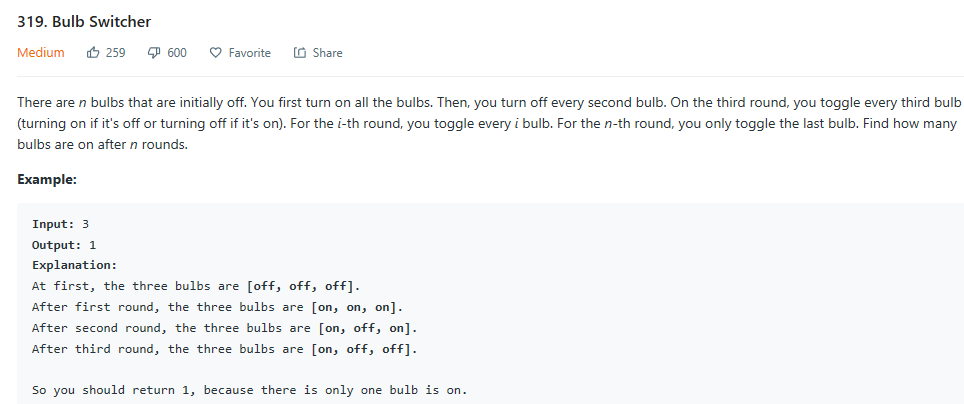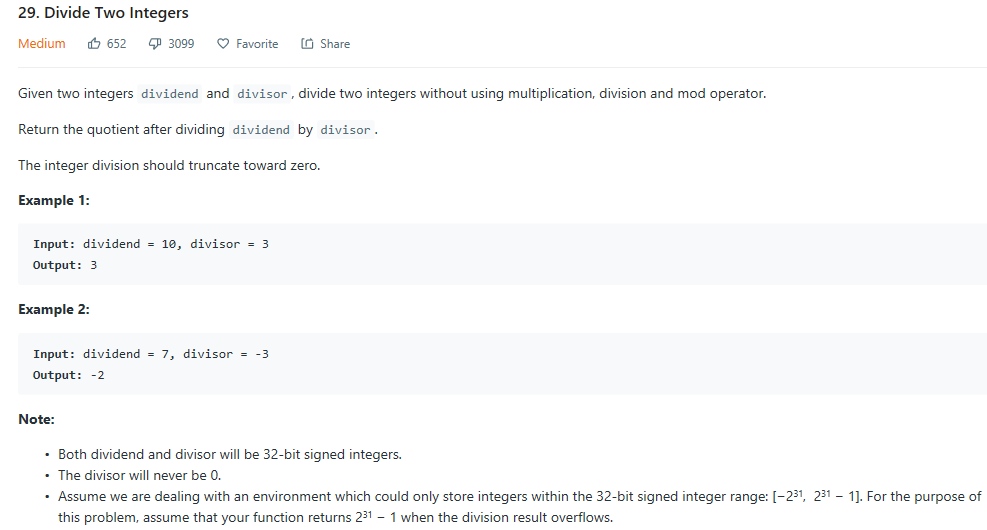
题意:n个灯泡,第一轮全部打开;第二轮每隔2k(k=0,1,...n)个(偶数2,4,6,8.....)关闭;第三轮3k(3,6,9,12,....)个打开;... 以此类推
所以当操作为奇数个时,灯是开的。而只有平方数的乘积个数为奇数。可以用sqrt(n)得到有1-n中多少个完全平方数。
class Solution { public: int bulbSwitch(int n) { return sqrt(n); } };

题意:两个32位的有符号整数,取值范围为[−231, 231 − 1]。求被除数(dividend)和除数(divisor)相除得到的整数的值。不能使用除法,乘法和求余操作。
思路:使用移位运算(左移一位相当于 乘2)将divisor逐一乘2来逼近dividend。
Suppose dividend = 15 and divisor = 3, 15 - 3 > 0. We now try to subtract more by shifting 3 to the left by 1 bit (6). Since 15 - 6 > 0, shift 6 again to 12. Now 15 - 12 > 0, shift 12 again to 24, which is larger than 15. So we can at most subtract 12 from 15. Since 12 is obtained by shifting 3 to left twice, it is 1 << 2 = 4 times of 3. We add 4 to an answer variable (initialized to be 0). The above process is like 15 = 3 * 4 + 3. We now get part of the quotient (4), with a remaining dividend 3.
Then we repeat the above process by subtracting divisor = 3 from the remaining dividend = 3 and obtain 0. We are done. In this case, no shift happens. We simply add 1 << 0 = 1 to the answer variable.
特殊情况:dividend = INT_MIN and divisor = -1, 即当被除数是−231 ,除数是-1时,得到的结果为231,超出了int的范围,此时应返回INT_MAX。
1)labs(long n) //回长整型参数n的绝对值
2)条件 ?a : b // 若条件为真,结果为a, 为假,结果为b
3)^符号表示:按位异或运算符。
参与运算的两个值,如果两个相应位相同,则结果为0,否则为1。即:0^0=0, 1^0=1, 0^1=1, 1^1=0
注意:m,n的类型不能定义为int,因为当dividend和divisor为−231时,绝对值后会超出整型的范围,所以要将m和n定义为long。

class Solution { public: int divide(int dividend, int divisor) { if(dividend==INT_MIN && divisor==-1) return INT_MAX; else{ long m = labs(dividend), n = labs(divisor), res = 0; int sign = (dividend < 0)^(divisor<0)? -1:1 ; if(n==1) return sign ==1 ? m:-m; while(m>=n){ long t = n, p = 1; while(m>= (t<<1)){ t <<= 1; p <<= 1; } res += p; m -= t; } return sign==1? res: -res; } } };
